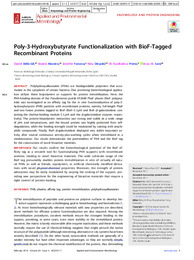Por favor, use este identificador para citar o enlazar este ítem:
https://hdl.handle.net/11000/4586Registro completo de metadatos
| Campo DC | Valor | Lengua/Idioma |
|---|---|---|
| dc.contributor.author | Bello Gil, Daniel | - |
| dc.contributor.author | Maestro García-Donas, Beatriz | - |
| dc.contributor.author | Fonseca, Jennifer | - |
| dc.contributor.author | Dinjaski, Nina | - |
| dc.contributor.author | Prieto, M. Auxiliadora | - |
| dc.contributor.author | Sanz, Jesús M. | - |
| dc.contributor.other | Departamentos de la UMH::Bioquímica y Biología Molecular | es |
| dc.date.accessioned | 2018-04-10T11:25:28Z | - |
| dc.date.available | 2018-04-10T11:25:28Z | - |
| dc.date.created | 2017-11-01 | - |
| dc.date.issued | 2018-04-10 | - |
| dc.identifier.issn | 0099-2240 | - |
| dc.identifier.issn | 1098-5336 | - |
| dc.identifier.uri | http://hdl.handle.net/11000/4586 | - |
| dc.description.abstract | Polyhydroxyalkanoates (PHAs) are biodegradable polyesters that accumulate in the cytoplasm of certain bacteria. One promising biotechnological application utilizes these biopolymers as supports for protein immobilization. Here, the PHA-binding domain of the Pseudomonas putida KT2440 PhaF phasin (BioF polypeptide) was investigated as an affinity tag for the in vitro functionalization of poly-3- hydroxybutyrate (PHB) particles with recombinant proteins, namely, full-length PhaF and two fusion proteins tagged to BioF (BioF–C-LytA and BioF–_-galactosidase, containing the choline-binding module C-LytA and the _-galactosidase enzyme, respectively). The protein-biopolyester interaction was strong and stable in a wide range of pHs and temperatures, and the bound protein was highly protected from selfdegradation, while the binding strength could be modulated by coating with amphiphilic compounds. Finally, BioF–_-galactosidase displayed very stable enzymatic activity after several continuous activity-plus-washing cycles when immobilized in a minibioreactor. Our results demonstrate the potentialities of PHA and the BioF tag for the construction of novel bioactive materials. | en |
| dc.description.sponsorship | This work was supported by the Spanish Ministry of Economy and Competitiveness (grants BFU2010-17824) | - |
| dc.description.sponsorship | This work was supported by the Spanish Ministry of Economy and Competitiveness (Grants BIO2013-44878-R) | - |
| dc.description.sponsorship | This work was supported by the Spanish Ministry of Economy and Competitiveness (Grants BIO2013-47684-R) | - |
| dc.description.sponsorship | This work was supported by the Spanish Ministry of Economy and Competitiveness (Grants BIO2016-79323-R) | - |
| dc.description.sponsorship | Tthe Community of Madrid (Spain) (NanoBIOSOMA S20 1473 3/M lT-2807). | - |
| dc.format | application/pdf | en |
| dc.format.extent | 12 | es |
| dc.language.iso | eng | en |
| dc.rights | info:eu-repo/semantics/openAccess | en |
| dc.subject | PHB | en |
| dc.subject | phasins | en |
| dc.subject | affinity tag | en |
| dc.subject | protein immobilization | en |
| dc.subject | polyhydroxyalkanoates | en |
| dc.subject.other | 57 - Biología | es |
| dc.title | Poly-3-Hydroxybutyrate Functionalization with BioF-Tagged Recombinant Proteins | en |
| dc.type | info:eu-repo/semantics/article | en |
| dc.contributor.institute | Instituto de Biología Molecular y Celular | es |
| dc.identifier.doi | 10.1128/AEM.02595-17 | - |
| dc.relation.publisherversion | https://doi.org/10.1128/AEM.02595-17 | - |

Ver/Abrir:
1-aem02595-17_Proof.pdf
2,18 MB
Adobe PDF
Compartir:
 La licencia se describe como: Atribución-NonComercial-NoDerivada 4.0 Internacional.
La licencia se describe como: Atribución-NonComercial-NoDerivada 4.0 Internacional.
.png)